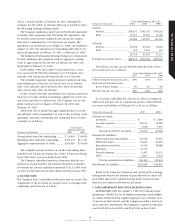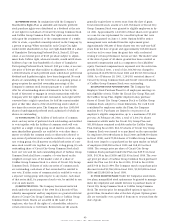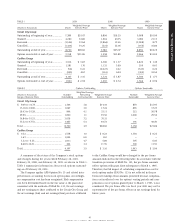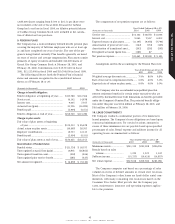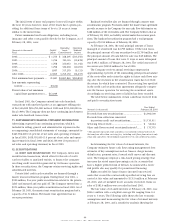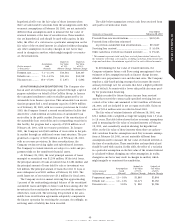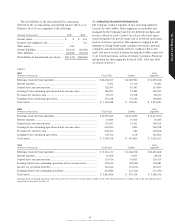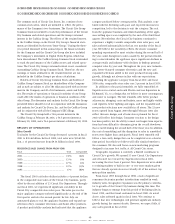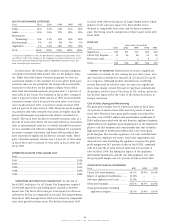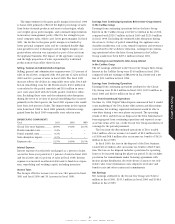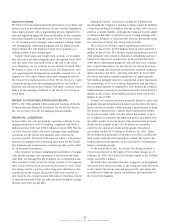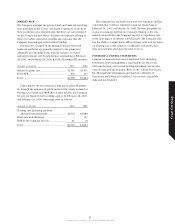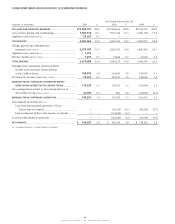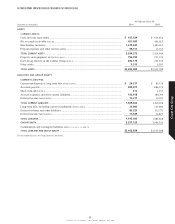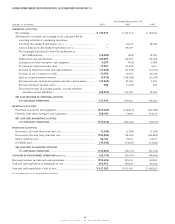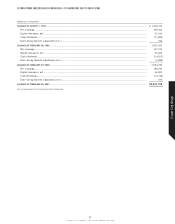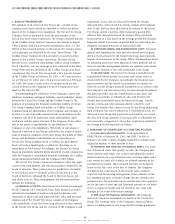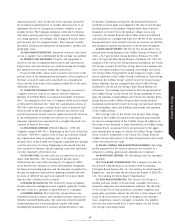CarMax 2001 Annual Report Download - page 52
Download and view the complete annual report
Please find page 52 of the 2001 CarMax annual report below. You can navigate through the pages in the report by either clicking on the pages listed below, or by using the keyword search tool below to find specific information within the annual report.
Circuit City Group
The common stock of Circuit City Stores, Inc. consists of two
common stock series, which are intended to reflect the perfor-
mance of the Company's two businesses. The Circuit City Group
Common Stock is intended to track the performance of the Circuit
City business and related operations and the Group’s retained
interest in the CarMax Group. The effects of the retained interest
in the CarMax Group on the Circuit City Group’s financial state-
ments are identified by the term “Inter-Group.” During the three-
year period discussed in this annual report, the financial results
for the Company and the Circuit City Group also have included
the Company's investment in Digital Video Express, which has
been discontinued. The CarMax Group Common Stock is intended
to track the performance of the CarMax stores and related opera-
tions. The Circuit City Group’s retained interest is not considered
outstanding CarMax Group Common Stock. Therefore, the net
earnings or losses attributed to the retained interest are not
included in the CarMax Group’s per share calculations.
Holders of Circuit City Group Common Stock and holders of
CarMax Group Common Stock are shareholders of the Company
and as such are subject to all of the risks associated with an invest-
ment in the Company and all of its businesses, assets and liabili-
ties. The results of operations or financial condition of one Group
could affect the results of operations or financial condition of the
other Group. The discussion and analysis for the Circuit City Group
presented below should be read in conjunction with the discussion
and analysis for Circuit City Stores, Inc. and for the CarMax Group
and in conjunction with all the Company’s SEC filings.
The Circuit City Group held a 74.6 percent interest in the
CarMax Group at February 28, 2001, a 74.7 percent interest at
February 29, 2000, and a 76.6 percent interest at February 28, 1999.
RESULTS OF OPERATIONS
Sales Growth
Total sales for the Circuit City Group decreased 1 percent in fiscal
2001 to $10.46 billion. In fiscal 2000, total sales were $10.60 bil-
lion, a 13 percent increase from $9.34 billion in fiscal 1999.
PERCENTAGE SALES CHANGE FROM PRIOR YEAR
Fiscal Total Comparable
2001...................................................................... (1)% (4)%
2000...................................................................... 13 % 8 %
1999...................................................................... 17 % 8 %
1998...................................................................... 12 % (1)%
1997...................................................................... 6 % (8)%
The fiscal 2001 total sales decline includes a 4 percent decline
in the comparable store sales of the Circuit City business, partly
offset by the net addition of 23 Circuit City Superstores. Through-
out fiscal 2001, we experienced significant variability in the
Circuit City comparable store sales pace. The sales pace in the
major appliance category softened significantly at the end of the
first quarter and into the second quarter. In late July, we
announced plans to exit the appliance business and expand our
selection of key consumer electronics and home office products.
A product profitability analysis had indicated that the appliance
category produced below-average profits. This analysis, com-
bined with the declining sales pace and expected increases in
competition, led to the decision to exit the category. The exit
from the appliance business and remerchandising of the appli-
ance selling space was completed by the end of the third fiscal
quarter. Nevertheless, the Circuit City business continued to
experience a highly variable comparable store sales pace, and
sales softened substantially in the last two months of the fiscal
year. We believe the variability reflects the slower consumer
spending experienced by most retailers during the second half of
the year, some disruption to sales caused by the partial remodel-
ing to remerchandise the appliance space, significant declines in
average retails and industry-wide declines in desktop personal
computer sales by year-end. Throughout the year, new technolo-
gies, better-featured consumer electronics and the new and
expanded selections added to the store produced strong sales
growth, although not always in line with our expectations.
Excluding the appliance category from fiscal 2001 and fiscal
2000 sales, comparable store sales rose 3 percent in fiscal 2001.
In addition to the partial remodels, we fully remodeled 25
Superstores in central and south Florida and one Superstore in
Richmond, Va., to a design that we believe is more contemporary
and easier to navigate. The full remodels offer better product
adjacencies, shopping carts and baskets, more and highly visible
cash registers, better lighting and signs, and the expanded and
new product selections now available in all stores. The 23 new
stores opened from August 2000 through February 2001 also
reflect this new design, and all new stores planned for fiscal
2002 will reflect this design. Consumer reaction to the design
has been positive, but the ability to meet our longer-term expecta-
tions has been difficult to determine given the overall slowdown
that occurred during the second half of the fiscal year. In addition,
the cost of remodeling and the disruption to sales in remodeled
stores were higher than anticipated. Fiscal 2002 remodels will
follow a less costly design that can be completed over a shorter
time period, but which we believe will offer similar benefits to
the consumer. We also will focus on new marketing programs
designed to increase foot traffic at all Circuit City stores.
Geographic expansion is currently a limited contributor to
Circuit City’s growth. We opened 23 new Circuit City Superstores
and relocated two Circuit City Superstores in fiscal 2001,
increasing the store base 4 percent. New Superstores were added
to existing markets or built in one- or two-store markets given
that we already operate stores in virtually all of the nation’s top
metropolitan markets.
From fiscal 1997 through fiscal 1998, a lack of significant
consumer electronics product introductions resulted in weak
industry sales. Geographic expansion was the primary contribu-
tor to growth of the Circuit City business during this time. The
industry began to emerge from this period of declining sales in
fiscal 1999, and that trend continued in fiscal 2000. As noted
above, sales softened again in fiscal 2001. We continue to
believe that new technologies will generate significant industry
growth during the current decade. However, we expect little, if
any, sales growth in fiscal 2002.
49
CIRCUIT CITY STORES, INC. 2001 ANNUAL REPORT
Circuit City Group Managements Discussion and
Analysis of Results of Operations and Financial Condition


